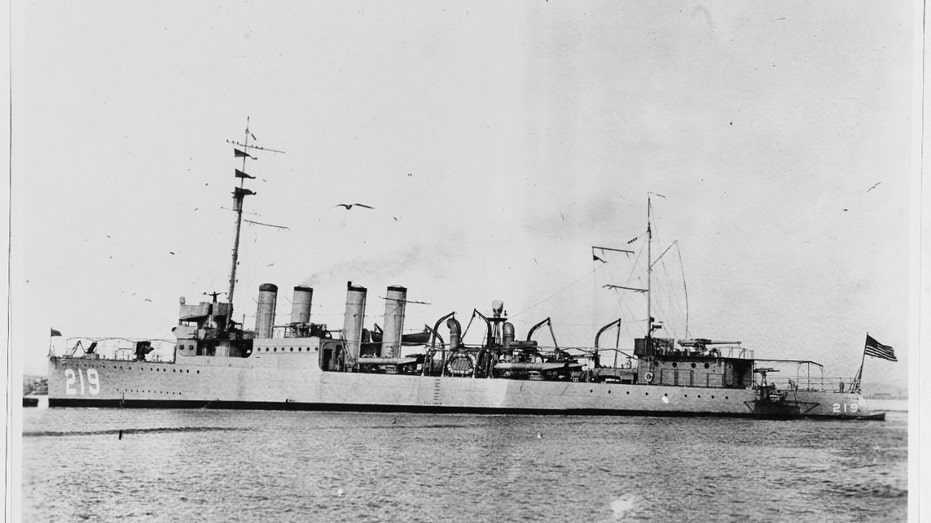
The wreckage of the USS Edsall, an American warship that was sunk during a battle with Japanese forces in World War II, has been discovered more than 80 years after it was lost at the bottom of the sea, U.S. and Australian officials announced Monday.
The final resting place of the USS Edsall, a Clemson-class destroyer, was discovered late last year at the bottom of the Indian Ocean, according to the U.S. Navy and Royal Australian Navy.
“Working in collaboration with the U.S. Navy, the Royal Australian Navy used advanced robotic and autonomous systems, normally used for hydrographic survey capabilities, to locate USS Edsall on the sea-bed,” Chief of Royal Australian Navy, Vice Admiral Mark Hammond, said in a statement.
The warship was sunk on March 1, 1942, three months after the attack on Pearl Harbor, during an encounter with Japanese battleships and dive bombers.
VETERANS DAY SPOTLIGHT: AMERICA’S GREATEST ATHLETES THAT TRADED THE BALLPARK FOR THE BATTLEFIELD
“Captain Joshua Nix and his crew fought valiantly, evading 1,400 shells from Japanese battleships and cruisers, before being attacked by 26 carrier-dive bombers, taking only one fatal hit. There were no survivors,” Caroline Kennedy, the U.S. ambassador to Australia, said in a statement.
Japanese forces spotted the Edsall about 225 miles south of Christmas Island as the U.S. warship was en route to aid another ship. Historians have said that the Edsall sustained previous damage that would prevent it from outrunning any of the Japanese cruisers or battleships.
Put into a “hopeless” position, historians say Nix, in an act of defiance against the enemy, “chose to make a fight of it,” laying a smoke screen and commencing evasive maneuvers that thwarted the Japanese aim for more than an hour before being overcome by dive bombers.
Nix’s evasive actions earned the respect of the Japanese, who said the Edsall performed like a “Japanese dancing mouse,” a popular pet in Japan at the time that was known for its manic movements.
“The commanding officer of Edsall lived up to the U.S. Navy tenet, ‘Don’t give up the ship,’ even when faced with overwhelming odds,” Lisa Franchetti, the U.S. Navy chief of naval operations, said in a statement.
“The wreck of this ship is a hallowed site, serving as a marker for the 185 U.S. Navy personnel and 31 U.S. Army Air Force pilots aboard at the time, almost all of whom were lost when Edsall succumbed to her battle damage,” the statement continued.
While it was believed all those aboard the Edsall died at sea, it was later learned, many years after the war ended, that a few survivors were picked up by the Japanese and beheaded on March 24, 1942.
Kennedy said the discovery is part of continued efforts to honor those who made the ultimate sacrifice.
“We will now be able to preserve this important memorial and hope that the families of the heroes who died there will know their loved ones rest in peace,” she said.
The wreckage of the USS Edsall, an American warship that was sunk during a battle with Japanese forces in World War II, has been discovered more than 80 years after it was lost at the bottom of the sea, U.S. and Australian officials announced Monday.
The final resting place of the USS Edsall, a Clemson-class destroyer, was discovered late last year at the bottom of the Indian Ocean, according to the U.S. Navy and Royal Australian Navy.
“Working in collaboration with the U.S. Navy, the Royal Australian Navy used advanced robotic and autonomous systems, normally used for hydrographic survey capabilities, to locate USS Edsall on the sea-bed,” Chief of Royal Australian Navy, Vice Admiral Mark Hammond, said in a statement.
The warship was sunk on March 1, 1942, three months after the attack on Pearl Harbor, during an encounter with Japanese battleships and dive bombers.
VETERANS DAY SPOTLIGHT: AMERICA’S GREATEST ATHLETES THAT TRADED THE BALLPARK FOR THE BATTLEFIELD
“Captain Joshua Nix and his crew fought valiantly, evading 1,400 shells from Japanese battleships and cruisers, before being attacked by 26 carrier-dive bombers, taking only one fatal hit. There were no survivors,” Caroline Kennedy, the U.S. ambassador to Australia, said in a statement.
Japanese forces spotted the Edsall about 225 miles south of Christmas Island as the U.S. warship was en route to aid another ship. Historians have said that the Edsall sustained previous damage that would prevent it from outrunning any of the Japanese cruisers or battleships.
Put into a “hopeless” position, historians say Nix, in an act of defiance against the enemy, “chose to make a fight of it,” laying a smoke screen and commencing evasive maneuvers that thwarted the Japanese aim for more than an hour before being overcome by dive bombers.
Nix’s evasive actions earned the respect of the Japanese, who said the Edsall performed like a “Japanese dancing mouse,” a popular pet in Japan at the time that was known for its manic movements.
“The commanding officer of Edsall lived up to the U.S. Navy tenet, ‘Don’t give up the ship,’ even when faced with overwhelming odds,” Lisa Franchetti, the U.S. Navy chief of naval operations, said in a statement.
“The wreck of this ship is a hallowed site, serving as a marker for the 185 U.S. Navy personnel and 31 U.S. Army Air Force pilots aboard at the time, almost all of whom were lost when Edsall succumbed to her battle damage,” the statement continued.
While it was believed all those aboard the Edsall died at sea, it was later learned, many years after the war ended, that a few survivors were picked up by the Japanese and beheaded on March 24, 1942.
Kennedy said the discovery is part of continued efforts to honor those who made the ultimate sacrifice.
“We will now be able to preserve this important memorial and hope that the families of the heroes who died there will know their loved ones rest in peace,” she said.






